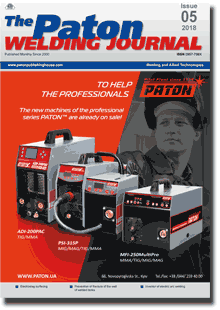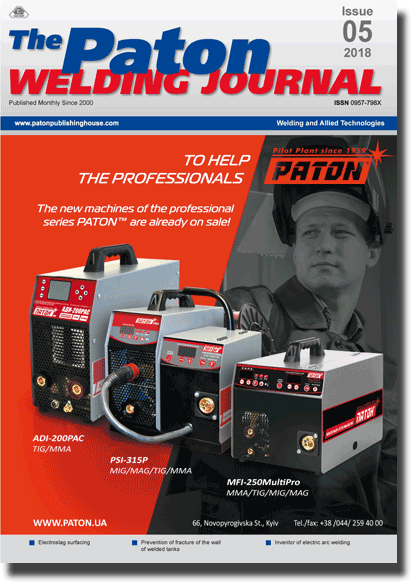| 2018 №05 (06) |
DOI of Article 10.15407/tpwj2018.05.07 |
2018 №05 (01) |

The Paton Welding Journal, 2018, #5, 31-36 pages
Modern hardware-software complexes for training of welders
L.M. Lobanov1, N.M. Makhlin1, A.E. Korotynsky1, V.E. Vodolazsky1 and V.Yu. Buryak1
1E.O. Paton Electric Welding Institute of the NAS of Ukraine 11 Kazimir Malevich Str., 03150, Kyiv, Ukraine. E-mail: office@paton.kiev.ua 2SE «Scientific and Engineering Center of Welding and Control in Nuclear Power Engineering of Ukraine of the E.O. Paton Electric Welding Institute of the NAS of Ukraine 11 Kazimir Malevich Str., 03150, Kyiv, Ukraine. E-mail: electro@paton.kiev.ua
The article presents the results of development of technical means of semi-virtual type for training welders and welding production specialists at the SE «Scientific and Engineering Center of Welding and Control in Nuclear Power Engineering» (SEC WCNPE) in cooperation with the E.O. Paton Electric Welding Institute of the NAS of Ukraine and the G.E. Pukhov IPME of the NAS of Ukraine. The level of development of technical means, attained at the present time, for training and certification of welders and welding production specialists was considered, which allows predicting the expansion in the fields of application of modern information technologies, including those reproducing the mixed reality at maximum adaptation of virtual space to the real welding equipment and providing the remote access of telecommunication systems. It was shown that simplification of training and its approximation to the conditions of real welding processes is possible by using a new generation of welding simulators, in which modern information technologies are widely applied. 15 Ref., 3 Figures.
Keywords: virtual reality, information technologies, arc welding simulators, training, welding equipment, certification of welders
Received: 20.03.18
Published: 07.05.18
References
1. Paton, B.E., Korotynsky, A.E., Bogdanosvky, V.A. et al. (2010) Information technologies in education of welders and specialists of welding production: Methodology and technical means. Svarka i Diagnostika, 3, 37–44 [in Russian].
2. Vasiliev, V.V., Simak, L.A., Bogdanovsky, V.A. et al. (2003) Simulation modeling and training-education systems in electric welding. Kiev, NASU [in Russian].
3. Koboyashi, K., Kato, H., Shimamoto, S. (2004) Modified training system for manual arc welding by using mixed reality and investigation of its effectiveness. Japan Society for Precision Engineering, 70(7), 941–945. https://doi.org/10.2493/jspe.70.941
4. Heston, T. (2008) Virtually welding: A tour of welding simulators that could help the manufacturing word rethink welding training. Fabricator, 38(3), 56–59.
5. Porter, N., Cote, J., Gifford, T., Lam, W. (2006) Virtual reality welded training. of Ship Production, 22(3), 126–138.
6. Hasimoto, N., Kato, H., Ikehara, R. (2006) Training system for manual arc welding by using mixed reality–reduction of position–perception error of electrode tip. Japan Society for Precision Engineering, 72(2), 249–253.
7. Product description Fronius virtual weldin www.fronius.com/cps/rde/xchg/SID-BFA25696-036863A3/fronius_international/hs.xsl/79_15490_ENG_HTML.htm
8. (2018) Fronius Company as a pioneer of implementation of digital and communication technologies. Svarka, 2, 59–61.
9. Keitel, S., Ahrens, C., Moll, H. (2014) Computer-based technologies and their influence on welding education. Ibid., 10, 51–55. https://doi.org/10.15407/tpwj2014.10.10
10. Danilyak, S.N. (1990) Problems of design of measuring transducers for control of heat content of welding pool and speed of welding simulators. Modeling in simulating systems. Kiev, Naukova Dumka [in Russian].
11. Bigdash, V.D. (1990) Devices of welding rate control in welding simulating systems. In: Modeling in simulator systems. Kiev, Naukova Dumka, 143–150 [in Russian].
12. Paton, B.E., Korotynsky, O.E., Bogdanovsky, V.O. et al. (2009) Method of evaluation of welding arc movements parameters in arc simulating systems. Pat. 86609, Ukraine [in Ukrainian].
13. Lobanov, L.M., Makhlin, N.M., Korotynsky, A.E. et al. (2018) Resistometric method of welding speed measurement for simulating welding systems. The Paton Welding J., 1, 8–13. https://doi.org/10.15407/tpwj2018.01.02
14. Vasiliev, V.V., Grezdov, G.I., Simak, L.A. et al. (2002) Modeling of dynamic systems: Aspects of monitoring and signal processing. by V.V. Vasiliev. Kyiv, NASU [in Russian].
15. Simak, L.A. (1984) Method of automatic determination of probe coordinates in conducting medium on the base of differential transformations. Elektronnoe Modelirovanie, 6, 90–91 [in Russian].
Suggested Citation
L.M. Lobanov, N.M. Makhlin, A.E. Korotynsky, V.E. Vodolazsky and V.Yu. Buryak (2018) Modern hardware-software complexes for training of welders. The Paton Welding J., 05, 31-36.The cost of subscription/purchase order journals or individual articles
| Journal/Currency | Annual Set | 1 issue printed |
1 issue |
one article |
| TPWJ/USD | 384 $ | 32 $ | 26 $ | 13 $ |
| TPWJ/EUR | 348 € | 29 € | 24 € | 12 € |
| TPWJ/UAH | 7200 UAH | 600 UAH | 600 UAH | 280 UAH |
| AS/UAH | 1800 UAH | 300 UAH | 300 UAH | 150 UAH |
| AS/USD | 192 $ | 32 $ | 26 $ | 13 $ |
| AS/EUR | 180 € | 30 € | 25 € | 12 € |
| SEM/UAH | 1200 UAH | 300 UAH | 300 UAH | 150 UAH |
| SEM/USD | 128 $ | 32 $ | 26 $ | 13 $ |
| SEM/EUR | 120 € | 30 € | 25 € | 12 € |
| TDNK/UAH | 1200 UAH | 300 UAH | 300 UAH | 150 UAH |
| TDNK/USD | 128 $ | 32 $ | 26 $ | 13 $ |
| TDNK/EUR | 120 € | 30 € | 25 € | 15 € |
AS = «Automatic Welding» - 6 issues per year;
TPWJ = «PATON WELDING JOURNAL» - 12 issues per year;
SEM = «Electrometallurgy Today» - 4 issues per year;
TDNK = «Technical Diagnostics and Non-Destructive Testing» - 4 issues per year.


